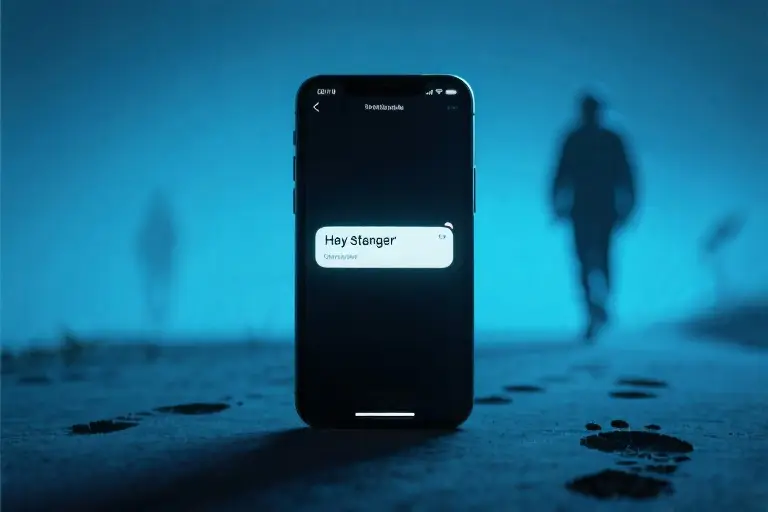The notification chime cuts through your evening—that familiar ding you haven’t heard in months. Your thumb hovers over the screen as the sender’s name triggers a visceral reaction: a skipped heartbeat, a rush of warmth to your cheeks, fingers that refuse to swipe open. “Hey, how are you?” reads the message, casual as a grocery list, devoid of any acknowledgment of the radio silence that left you dissecting every past interaction for clues.
You’d rehearsed this moment during those 3am spirals—the sharp comebacks, the dignified indifference, maybe even the tearful reconciliation. But now that it’s here, you’re paralyzed by the whiplash of emotions: the flutter of hope that maybe this time will be different, the acidic burn of resentment at their audacity, and beneath it all, that old familiar ache—why now, when I’ve finally stopped waiting?
This is the emotional manipulation dance of our digital age. Ghosters who vanish mid-conversation only to reappear when your Instagram stories show you laughing again. Exes who resurface after years with “just checking in” texts during their late-night scrolls. Friends who treat your empathy like an on-demand service, available after months of unexplained absence. Their returns rarely correlate with genuine remorse—instead, they follow predictable patterns of self-serving timing:
- The Holiday Hail Mary: A “Merry Christmas!” text when family gatherings highlight their loneliness
- The Benchmark Bounceback: Reaching out precisely when life milestones (your promotion, their breakup) destabilize their ego
- The Nostalgia Drive-By: A shared memory resurfaced (“Remember that taco place?”) when their new relationships hit routine
What makes these encounters so destabilizing isn’t just the unanswered questions—it’s how they exploit our hardwired social instincts. UCLA neuroscience research shows that ambiguous social cues (Why did they word it that way?) activate the same brain regions as physical pain. Our minds, desperate for resolution, will fabricate explanations (Maybe they were depressed!) rather than sit with the simpler truth: their reappearance says everything about their current needs, and nothing about your enduring value.
“They return to see if you’ll still open the door,” writes relationship expert Saiki, pinpointing the laboratory-mice nature of these interactions. The message isn’t an olive branch—it’s a behavioral probe. Will you:
A) Respond immediately with enthusiastic forgiveness (confirming their continued emotional leverage)
B) React with hurt/anger (still proving they occupy mental real estate)
C) Remain silent (the only response that actually shifts power dynamics)
This isn’t cynicism—it’s pattern recognition. Healthy relationships don’t operate in vanishing acts. When someone genuinely values you, their presence isn’t seasonal. They don’t treat your trust like a novelty item they can dust off when nostalgic. Most importantly, they take accountability for disruptions in your connection rather than pretending months of silence never happened.
So breathe through that adrenaline surge. Notice how your body reacts to their name—not just the hopeful leap, but the tension in your shoulders, the protective curl of your fingers. That somatic wisdom knows what your optimistic heart struggles to accept: some returns aren’t reconciliations. They’re audits.
The cursor blinks in your reply box, an open invitation to restart a cycle you’ve worked hard to escape. But here’s the secret they don’t want you to know: You get to decide if this ding deserves your attention. Not because you’re bitter, but because you’ve learned the difference between being available and being available at your own expense.
When “Hey, How Are You?” Pops Up After Radio Silence
That notification sound—the one you used to strain your ears for—just shattered your afternoon. Your thumb hovers over the screen as your pulse does that traitorous little skip. The name glowing there belongs to someone who mastered the art of making you feel invisible, yet here they are, typing casual words as if the past months (or years) of silence were just a technical glitch.
The emotional whiplash is real:
- Your rational brain fires warning flares (“Don’t engage”)
- Your nervous system remembers the dopamine hits of their attention (“But what if…”)
- Your fingers develop a mind of their own, itching to type “Where have you been?!” or worse—“I’m good!” like some cheerful NPC in their emotional video game
The Anatomy of an Emotional Ping
These digital breadcrumbs share uncanny similarities:
- The Nonchalant Opener:
- No reference to their disappearance (“Hey stranger” counts as emotional fraud)
- Zero accountability packaged as friendliness (“How’s life?”)
- The Timing Tells All:
- Often coincides with your social media post showing you thriving
- Or arrives during predictable vulnerability hours (Friday nights, holidays)
- The Bait Design:
- Vague enough to deny intention (“Just checking in!”)
- Specific enough to trigger memories (“Remember that taco place?”)
What your body knows before your mind admits it: That sinking sensation in your stomach isn’t anxiety—it’s your intuition recognizing emotional manipulation patterns. The chills down your spine aren’t excitement—they’re your nervous system remembering how this person made you question your worth.
The Psychological Crossroads
You’re now facing two versions of yourself:
Past You who:
- Analyzed their “last active” status like a forensic investigator
- Drafted paragraphs only to delete them
- Felt phantom phone vibrations hoping for contact
Present You who:
- Finally stopped jumping at notifications
- Rediscovered hobbies they’d sidelined
- Started filling the silence with self-worth instead of their absence
That simple message just dragged both versions into the same boxing ring. But here’s the secret: You get to decide which one steps into the conversation.
The Unspoken Subtext
When someone reappears after ghosting, their message isn’t really about you—it’s a psychological probe:
- If you respond enthusiastically → They confirm their power (“Still hooked”)
- If you’re cold/distant → They file you under “Not an option”
- If you ignore it → They’ll likely vanish again… until next time
This isn’t communication—it’s emotional market research. And you’re being surveyed without consent.
“The healthiest response to someone testing your boundaries isn’t anger or excitement—it’s bored curiosity. Like watching a cat poke at a closed door it has no intention of walking through.”
Your New Response Toolkit
Before your fingers betray you, try this:
- The 24-Hour Rule
- Let the message sit while you observe your emotional weather
- Note if your urge to reply feels like choice or compulsion
- The Subtext Translator
- “Hey stranger” = “I’m seeing if you’ll ignore my disrespect”
- “We should catch up!” = “I want attention with zero commitment”
- The Power of “Oh?”
- A neutral, unbothered response disrupts their script
- Example: “Oh? What made you reach out now?” (Watch them fumble)
Remember: Every ignored red flag comes with an invoice. The price? Pieces of your peace. That “ding” wasn’t a new beginning—it’s an old pattern wearing a new notification. And you? You’ve already outgrown the person who sent it.
Why Do They Come Back? 6 Hidden Motivations Behind Sudden Returns
That notification pops up on your screen after months of radio silence. Your stomach does that familiar flip-flop as you read those deceptively simple words: “Hey, how are you?” Before you let yourself get swept up in nostalgia, let’s examine what’s really happening beneath the surface.
1. Testing Their Influence (“Are You Still on Their Hook?”)
This is the most common reason people reappear after ghosting. It’s not about reconnecting with you – it’s about verifying they still have emotional leverage. Think of it like checking if a light switch still works after years of disuse. Their message is the equivalent of flipping that switch to see if you’ll still light up for them.
Psychological studies call this “intermittent reinforcement” – the powerful behavioral conditioning that occurs when rewards (your attention) are given unpredictably. By disappearing then reappearing, they’ve accidentally created a psychological pattern that’s incredibly hard to break.
Key indicator: If their messages are vague, non-committal, and avoid addressing their previous disappearance.
2. Emotional Snacking (Filling Temporary Loneliness)
Like grabbing fast food when too tired to cook, some people return to ex-connections when their emotional pantry feels empty. You’re not their chosen nourishment – just convenient comfort food when their preferred options aren’t available.
Relationship experts note this often happens during life transitions – after breakups, job changes, or moves. You represent familiarity during instability, not because you’re uniquely valued.
Key indicator: They reach out during obvious low points (post-breakup, late nights, holidays) but disappear when life improves.
3. Ego Maintenance (Proving They’re Still Desirable)
Some returns are essentially emotional mirror-checking. After rejection or life setbacks, they need confirmation they’re still attractive/interesting. Your positive response becomes their self-esteem bandage.
This explains why some exes resurface after seeing your social media success or hearing you’ve moved on. Your growth threatens their narrative that you’d always be waiting.
Key indicator: Sudden interest after they notice your accomplishments or new relationship.
4. Nostalgia Baiting (Romanticizing the Past)
Memory has a funny way of filtering out negative experiences over time. What they miss isn’t actually you – it’s their edited mental highlight reel of the relationship. When reality fails to match this fantasy (which it always does), they’ll vanish again.
Psychologists call this “rosy retrospection” – our tendency to recall past events more positively than we experienced them.
Key indicator: They reference “remember when…” excessively while ignoring why things ended.
5. Social Capital Withdrawal (Accessing Your Network)
Sometimes returns are purely transactional. They might need professional connections, insider information, or social credibility your circle provides. Once their need is met, the connection fades again.
Key indicator: Requests for favors, introductions, or information dominate the conversation.
6. The Comparison Shopper (Checking Options)
In our dating app culture, some keep former connections “warm” just in case. You’re one of several they periodically check on, waiting to see who provides the best emotional ROI before committing attention.
Key indicator: Extremely sporadic contact (every 6-12 months) with no relationship progression.
The Common Thread: It’s About Them, Not You
Notice how none of these motivations involve genuine interest in your wellbeing? That’s the crucial insight. Healthy reconnections acknowledge past harm, express clear intentions, and respect your boundaries. These sudden returns skip all three.
When someone disappears then reappears without addressing the elephant in the room (their disappearance), they’re telling you everything you need to know. The door only swings one way in their mind – they control when it opens and closes. The question isn’t why they came back. The real question is: will you keep letting them treat your heart like a revolving door?
Being Needed vs. Being Valued: Reframing Your Perspective
That moment when their message pops up after radio silence—your breath catches, fingers hover over the screen. Part of you wants to respond immediately, another part screams Why now? This internal conflict reveals a crucial truth we often overlook: Being needed isn’t the same as being valued.
The Anatomy of Healthy Relationships
Genuine connections share three unmistakable traits:
- Consistency
Not perfection, but predictable effort—the kind that shows up during both easy Sundays and difficult Mondays. Unlike those who vanish when life gets complicated. - Reciprocal Investment
A two-way street where both parties:
- Initiate meaningful conversations
- Remember important details (“How did your presentation go?”)
- Respect response times without games
- Accountability
Healthy partners acknowledge missteps: “I realize my silence hurt you” versus “Hey stranger!” after ghosting for months.
Spot the difference: When someone reappears without addressing their absence, they’re treating the relationship like a convenience store—open 24/7 for their needs, with zero regard for your operating hours.
5 Red Flags of Testing-the-Waters Contact
These messages often disguise themselves as harmless check-ins. Look for these emotional manipulation tactics:
- The Time-Warp Greeting
“Hey you!” as if yesterday’s three-month gap doesn’t exist - Vague Fishing
“How’s life?” instead of “I owe you an apology for disappearing” - Nostalgia Baiting
“Remember that coffee place we loved?” (zero follow-up plans) - Convenience Timing
Messages coinciding with their birthdays, holidays, or visible life updates on your social media - The Slow Fade
Enthusiastic replies if you engage, then gradual withdrawal until next reappearance
Your Self-Worth Toolkit
When doubt creeps in (“Maybe they really care this time”), ask:
- Did they take responsibility for their absence?
- Are they curious about your emotional reality, not just sharing theirs?
- Would this behavior be acceptable from someone you truly respected?
Key Insight: People who value you don’t treat your connection like Wi-Fi—disconnecting at will and expecting automatic reconnection. They maintain the relationship even when it requires uncomfortable conversations.
Breaking the Cycle
That lingering urge to respond immediately? It often stems from conflating two very different hungers:
- The craving to be needed: “See? They still think about me”
- The need to be valued: “They prioritize my feelings consistently”
One fills your ego temporarily; the other nourishes your soul long-term. Recognizing this difference is how you stop mistaking breadcrumbs for banquets.
“Don’t confuse their ability to disrupt your peace with your inability to live without them.”
— Unknown
Every “ding” presents a choice: Will you reopen a door they’ve shown they’ll walk out of again, or invest that energy in connections with better emotional ROI? The answer lives in your quietest, most honest self—the part that already knows the difference between being someone’s option and becoming your own priority.
How to Respond? 3 Strategies to Protect Your Self-Worth
When that unexpected message appears after months of silence, your fingers might hover over the keyboard, torn between ignoring it and pouring out everything you’ve held back. This moment isn’t just about them—it’s about you reclaiming power in a dynamic that once left you questioning your value. Below are three thoughtful approaches to navigate these emotionally charged situations while keeping your self-worth intact.
Strategy 1: The 24-Hour Delay Rule
Your immediate emotional reaction isn’t always your wisest guide. When you receive that out-of-the-blue message:
- Step away: Close the messaging app immediately to avoid knee-jerk responses
- Journal first: Write down everything you’d like to say—this gets the emotional purge out of your system
- Sleep on it: Literally wait 24 hours before deciding whether and how to respond
Why this works: The delay creates space between their attempt to re-enter your life and your response. You’ll notice something revealing—after a day, the urgency to reply often diminishes significantly. This isn’t about playing games; it’s about breaking the pattern where their timing dictates your emotional state.
Strategy 2: Boundary Scripts for Different Scenarios
Not all ghosting-then-returning situations require the same approach. These templates maintain your dignity while establishing clear limits:
For casual connections:
“Hi [Name], I’ve moved forward since we last spoke. Wishing you well, but I’m not available to reconnect.”
For significant relationships where closure matters:
“If you’d like to discuss what happened between us, I’m open to a real conversation about [specific issue]. Otherwise, I’m focusing on my present relationships.”
When you suspect emotional manipulation:
No response is a complete response. Silence can be your most powerful boundary when someone tests whether you’ll still engage on their terms.
Pro tip: Type these in your notes app beforehand so they’re ready when needed. Emotional moments rarely bring out our most articulate selves.
Strategy 3: The “Irreplaceable Me” Inventory
Before crafting any reply, complete this written exercise:
- List 5 qualities you brought to the relationship that had nothing to do with them (e.g., “my sense of humor when times were tough”)
- Note 3 ways you’ve grown since they disappeared
- Write one truth you needed to hear during the ghosting period (“I deserved an explanation”)
This isn’t just feel-good busywork—it physically rewires your brain’s response. Neuroscience shows that handwriting self-affirmations activates the prefrontal cortex, reducing the emotional hijacking that makes us vulnerable to unhealthy relationship patterns.
The Unspoken Fourth Option: Sometimes the healthiest reply is recognizing you don’t owe one. Their sudden reappearance doesn’t automatically grant them access to your emotional energy—that privilege is yours to give or withhold.
As you consider these strategies, remember: their return says more about their unresolved issues than your worth. You get to decide whether, when, and how your door opens—if at all.
The Choice Is Yours: Reclaiming Your Power
That notification sound—the one you trained yourself not to jump for—just disrupted your peace again. Their name flashes on your screen with a casual greeting, as if the past months (or years) of silence were just a brief pause in conversation. You’ve been here before. The racing pulse, the hesitation before tapping the message, the internal debate between curiosity and self-preservation.
The Door Metaphor Revisited
Remember this: every relationship is a door with your hand on the knob. When someone reappears after ghosting, they’re not knocking to come in—they’re checking if the lock still responds to their touch. The power isn’t in their return; it’s in your decision to turn the deadbolt or leave it swinging in the wind.
Consider what changed since their disappearance:
- Your growth: The hobbies you cultivated, the friendships that deepened
- Your clarity: The realization that “availability” isn’t the same as “value”
- Your standards: The boundaries you promised yourself you’d enforce next time
Three Paths Forward
- The Unanswered
Sometimes silence speaks loudest. Not every message deserves your emotional labor—especially when their last one was radio silence. As therapist Nedra Tawwab notes: “Not responding is a response.” This isn’t petty; it’s preservation. - The Boundary Script
If you choose to engage, try this template:
“Hi [Name], I wasn’t expecting to hear from you. To be honest, the way things ended left me with some unresolved feelings. I’d need [specific change] to consider reconnecting.”
Watch their response. Do they acknowledge your feelings or deflect?
- The Redirect
Reply with a question that exposes intentions:
“What made you reach out now?”
Their answer reveals everything—nostalgia, loneliness, or genuine accountability.
Your New Litmus Test
Before responding, ask:
- Does this person have consistent access to me, or only when convenient?
- Am I their first thought or last resort?
- Does reconnecting expand my life or shrink it back to old patterns?
“Ghosters don’t get to set the terms of your healing timeline.” —Dr. Jennice Vilhauer
Where To Go From Here
If you’re struggling with this decision, our Emotional Boundary Toolkit breaks down:
- How to spot “testing” behavior (vs. genuine reconciliation)
- Phrases to disarm guilt-tripping
- A step-by-step self-worth audit
This time, the ending isn’t about their choices—it’s about yours. So tell me, with all you know now: Will you leave that door open?





